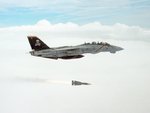Thanks Matt. Nobody seems to give the F/A-18's enough credit. The E/F models are especially potent warbirds. All most people seem to focus on are the sexy maneuvers performed by Russian stunt planes. Aerobatics won't win wars.
I think it's just that most people (myself included) are bitter about the Tomcat retiring. The F/A-18 has some big shoes to fill and it seems to be doing it rather nicely. I was particularly impressed with the new model performing as a tanker. Not to mention all the combat upgrades and all that

